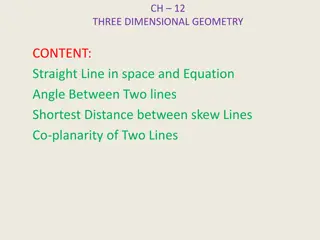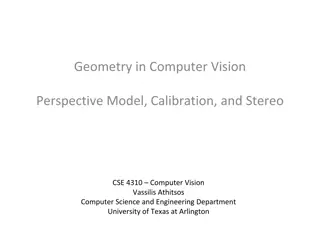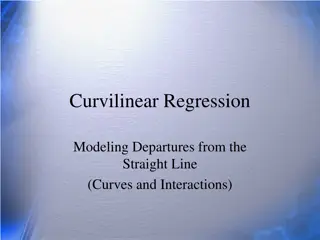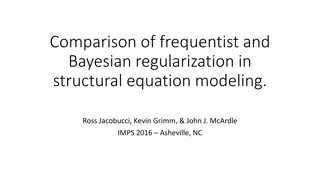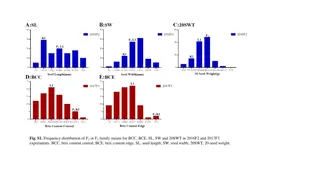Three-Dimensional Geometry: Direction Cosines and Angles
Understanding direction cosines and angles in three-dimensional geometry is crucial for determining the orientation of lines in space. By calculating direction cosines, we can find the angles a line makes with the positive directions of the X, Y, and Z axes. This knowledge helps in various geometric
2 views • 18 slides
Methods for Handling Collinearity in Linear Regression
Linear regression can face issues such as overfitting, poor generalizability, and collinearity when dealing with multiple predictors. Collinearity, where predictors are linearly related, can lead to unstable model estimates. To address this, penalized regression methods like Ridge and Elastic Net ca
4 views • 70 slides
3D Information in Computer Vision
Exploring the importance of estimating 3D information in computer vision applications, such as perspective camera models, stereo vision, and the transition from 2D to 3D representations. It discusses the need for detailed 3D data for tasks like object manipulation, obstacle detection for unmanned ve
4 views • 118 slides
Basic Geometrical Ideas in Geometry
Basic Geometrical Ideas in Geometry cover the fundamental concepts of points, lines, and planes. Points are described as having location but no size, lines are infinite sets of points, and collinearity is discussed. The importance of straightness in lines is assumed but not defined. Symbols and nota
5 views • 45 slides
R Short Course Session 5 Overview: Linear and Logistic Regression
In this session, Dr. Daniel Zhao and Dr. Sixia Chen from the Department of Biostatistics and Epidemiology at the College of Public Health, OUHSC, cover topics on linear regression including fitting models, checking results, examining normality, outliers, collinearity, model selection, and comparison
3 views • 44 slides
Curvilinear Regression
Discover the nuances of curvilinear regression, polynomial modeling, and interactions in statistical analysis. Understand the challenges of collinearity, explore quadratic and cubic trends, and learn the sequence of tests to model curves effectively. Dive into the difference between linear and nonli
0 views • 31 slides
Position and Displacement Vectors in Mathematics
Learn about position vectors, displacement vectors, resultant vectors, and collinearity of points in mathematics. Explore examples and understand how to find vectors and determine relationships between points using vector operations.
0 views • 8 slides
Position and Displacement Vectors in Mathematics
In mathematics, position vectors represent the position of a point relative to a fixed origin. Displacement vectors describe the movement between points using vectors. Learn how to find vectors, resultant vectors, and collinearity of points using examples. Enhance your understanding of vector operat
3 views • 20 slides
Comparison of Frequentist and Bayesian Regularization in SEM
Regularization techniques are increasingly utilized in structural equation modeling (SEM) for producing sparse solutions, overcoming collinearity, and enhancing generalizability. This overview explores the application of both frequentist and Bayesian approaches in SEM, discussing Regularized SEM (Re
2 views • 17 slides
Multiple Regression and Regularization Methods in Linear Regression
Explore the importance of evaluating regression fit, assumptions validation, feature selection, (multi)collinearity, Lasso, Ridge, splines, and more in linear regression. Learn why predictors should not be considered separately and how Ridge regression mitigates multicollinearity issues.
1 views • 6 slides
Mathematical Concepts in Euclidean Space
Explore various concepts in Euclidean space such as distances, vectors, dot products, and collinearity, illustrated with examples and visuals.
3 views • 21 slides
Genetic and Phenotypic Analysis of Fruit and Seed Traits
Explore the frequency distribution of family means for various traits in the 2016-2017 experiments, correlation matrix between traits, collinearity analysis, QTL detection across chromosomes, and QTL locations for fruit-related traits. View the global analysis and insights on brix content, seed dime
3 views • 6 slides
Discovering Geometry Concepts and Reasoning Strategies
Explore the fundamental concepts of geometry such as points, lines, angles, and rays. Understand the process of reasoning in geometry through pattern exploration, conjecture making, and logical verification. Get familiar with important definitions and classifications of angles while learning about c
3 views • 12 slides
Conference on Finance, Chicago: Collinearity Visualized by Renato Staub, Ph.D.
Join Renato Staub, Ph.D., Senior Risk Capital Analyst, at the Finance Conference in Chicago to explore collinearity visualization techniques. Informational material by William Blair's team on investment strategies and risks is also provided.
5 views • 18 slides
Advanced Modeling Techniques for Regression Analysis
Explore the intricacies of multiple regression analysis, including defining partial regression coefficients, handling collinearity, and understanding the impact of binary variables. Dive into examples and learn how to interpret results effectively.
1 views • 23 slides
Understanding Geometric Concepts with Examples
Explore geometric concepts such as lines, segments, rays, collinearity, coplanarity, and more through detailed examples and illustrations. Learn about parallel lines, intersecting lines, coplanar points, and planes to enhance your understanding of geometry fundamentals.
0 views • 23 slides
Understand Points, Lines, and Planes in Geometry
Explore the concept of points, lines, and planes in geometry through examples of collinearity, segments, and rays. Learn how to identify points on a plane and distinguish between segments and lines.
1 views • 8 slides
Vector Operations in Euclidean Space
Explore concepts like distance calculation, vector norms, dot product, and collinearity in Euclidean space involving vectors and coordinates.
1 views • 21 slides
Geometry Basics Explained
Dive into the fundamentals of geometry, from points and lines to postulates and segments. Understand definitions and examples with clear illustrations. Explore concepts like collinearity, coplanarity, congruence, and more.
0 views • 8 slides
Penalized Regression in Machine Learning
Explore penalized regression in machine learning and its advantages over traditional maximum likelihood estimation. Learn about subset selection methods, challenges with subset selection, and how collinearity affects model selection. Discover alternative methods for achieving model stability and acc
1 views • 64 slides
